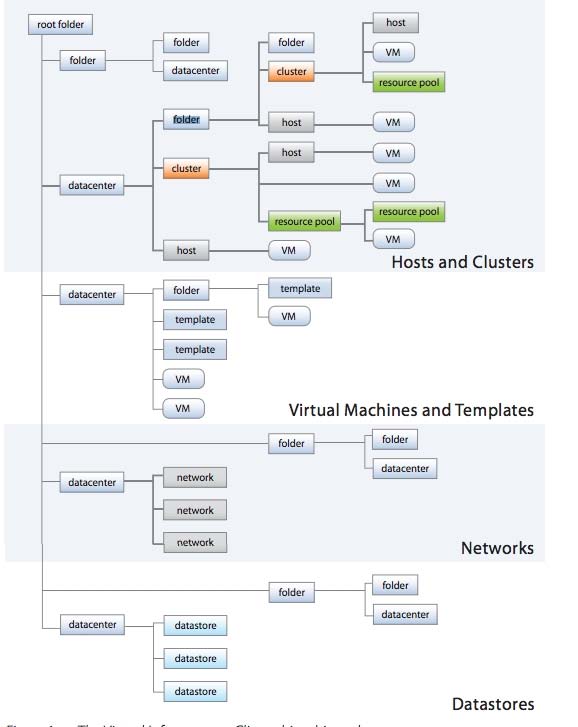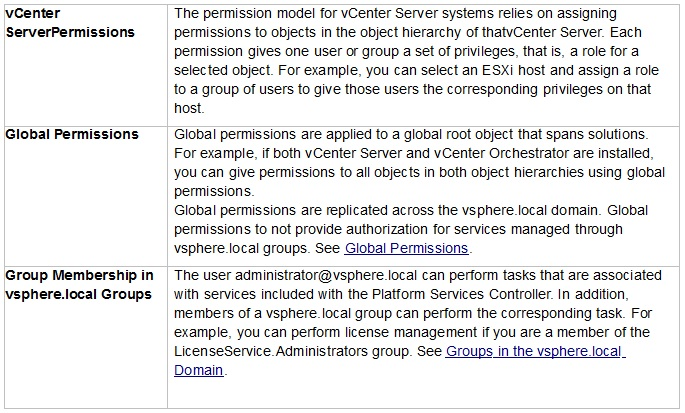VMware 2V0-621D Exam Practice Questions (P. 2)
- Full Access (245 questions)
- One Year of Premium Access
- Access to one million comments
- Seamless ChatGPT Integration
- Ability to download PDF files
- Anki Flashcard files for revision
- No Captcha & No AdSense
- Advanced Exam Configuration
Question #6
What is the highest object level from which a virtual machine can inherit privileges?
- AHost Folder
- BData Center
- CData Center Folder
- DVM Folder
Correct Answer:
C

Reference: http://www.vmware.com/pdf/vi3_vc_roles.pdf
C

Reference: http://www.vmware.com/pdf/vi3_vc_roles.pdf
send
light_mode
delete
Question #7
Which three Authorization types are valid in vSphere? (Choose three.)
- AGroup Membership in vsphere.local
- BGlobal
- CForest
- DvCenter Server
- EGroup Membership in system-domain
Correct Answer:
ABD
Sphere 6.0 and later allows privileged users to give other users permissions to perform tasks in the following ways. These approaches are, for the most part, mutually exclusive; however, you can assign use global permissions to authorize certain users for all solution, and local vCenter Server permissions to authorize other users for individual vCenter Server systems.

Reference: http://pubs.vmware.com/vsphere-60/index.jsp?topic=%2Fcom.vmware.vsphere.security.doc%2FGUID-74F53189-EF41-4AC1-A78E-
D25621855800.html -
See -
Global Permissions -
.
See -
Groups in the vsphere.local Domain
.
ABD
Sphere 6.0 and later allows privileged users to give other users permissions to perform tasks in the following ways. These approaches are, for the most part, mutually exclusive; however, you can assign use global permissions to authorize certain users for all solution, and local vCenter Server permissions to authorize other users for individual vCenter Server systems.

Reference: http://pubs.vmware.com/vsphere-60/index.jsp?topic=%2Fcom.vmware.vsphere.security.doc%2FGUID-74F53189-EF41-4AC1-A78E-
D25621855800.html -
See -
Global Permissions -
.
See -
Groups in the vsphere.local Domain
.
send
light_mode
delete
Question #8
Which three components should an administrator select when configuring vSphere permissions? (Choose three.)
- AInventory Object
- BRole
- CUser/Group
- DPrivilege
- EPassword
Correct Answer:
ABC
In vSphere, permission consists of a user or group and an assigned role for an inventory object, such as a virtual machine or ESX/ESXi host. Permissions grant users the right to perform the activities specified by the role on the object to which the role is assigned.
Reference: http://pubs.vmware.com/vsphere-4-esx-vcenter/index.jsp?topic=/com.vmware.vsphere.dcadmin.doc_41/vsp_dc_admin_guide/ managing_users_groups_roles_and_permissions/c_permissions.html
ABC
In vSphere, permission consists of a user or group and an assigned role for an inventory object, such as a virtual machine or ESX/ESXi host. Permissions grant users the right to perform the activities specified by the role on the object to which the role is assigned.
Reference: http://pubs.vmware.com/vsphere-4-esx-vcenter/index.jsp?topic=/com.vmware.vsphere.dcadmin.doc_41/vsp_dc_admin_guide/ managing_users_groups_roles_and_permissions/c_permissions.html
send
light_mode
delete
Question #9
In which two vsphere.local groups should an administrator avoid adding members? (Choose two.)
- ASolutionUsers
- BAdministrators
- CDCAdmins
- DExternalPDUsers
Correct Answer:
AB
The vsphere.local domain includes several predefined groups. Assign users to one of those groups to be able to perform the corresponding actions.
For all objects in the vCenter Server hierarchy, permissions are assigned by pairing a user and a role with the object. For example, you can select a resource pool and give a group of users read privileges to that resource pool by giving them the corresponding role.
For some services that are not managed by vCenter Server directly, privileges are determined by membership to one of the vCenter Single Sign-On groups. For example, a user who is a member of the Administrator group can manage vCenter Single Sign-On. A user who is a member of the CAAdmins group can manage the VMware Certificate Authority, and a user who is in the LicenseService.Administrators group can manage licenses.
Reference: https://pubs.vmware.com/vsphere-60/index.jsp?topic=%2Fcom.vmware.vsphere.security.doc%2FGUID-87DA2F34-DCC9-4DAB-8900-
1BA35837D07E.html
AB
The vsphere.local domain includes several predefined groups. Assign users to one of those groups to be able to perform the corresponding actions.
For all objects in the vCenter Server hierarchy, permissions are assigned by pairing a user and a role with the object. For example, you can select a resource pool and give a group of users read privileges to that resource pool by giving them the corresponding role.
For some services that are not managed by vCenter Server directly, privileges are determined by membership to one of the vCenter Single Sign-On groups. For example, a user who is a member of the Administrator group can manage vCenter Single Sign-On. A user who is a member of the CAAdmins group can manage the VMware Certificate Authority, and a user who is in the LicenseService.Administrators group can manage licenses.
Reference: https://pubs.vmware.com/vsphere-60/index.jsp?topic=%2Fcom.vmware.vsphere.security.doc%2FGUID-87DA2F34-DCC9-4DAB-8900-
1BA35837D07E.html
send
light_mode
delete
Question #10
An administrator has configured three vCenter Servers and vRealize Orchestrator within a Platform Services Controller domain, and needs to grant a user privileges that span all environments.
Which statement best describes how the administrator would accomplish this?
Which statement best describes how the administrator would accomplish this?
- AAssign a Global Permission to the user.
- BAssign a vCenter Permission to the user.
- CAssign vsphere.local membership to the user.
- DAssign an ESXi Permission to the user.
Correct Answer:
A
Global permissions are applied to a global root object that spans solutions, for example, both vCenter Server and vCenter Orchestrator. Use global permissions to give a user or group privileges for all objects in all object hierarchies.
Reference: http://pubs.vmware.com/vsphere-60/index.jsp?topic=%2Fcom.vmware.vsphere.security.doc%2FGUID-C7702E31-1623-4189-89CB-
E1136AA27972.html
A
Global permissions are applied to a global root object that spans solutions, for example, both vCenter Server and vCenter Orchestrator. Use global permissions to give a user or group privileges for all objects in all object hierarchies.
Reference: http://pubs.vmware.com/vsphere-60/index.jsp?topic=%2Fcom.vmware.vsphere.security.doc%2FGUID-C7702E31-1623-4189-89CB-
E1136AA27972.html
send
light_mode
delete
All Pages
